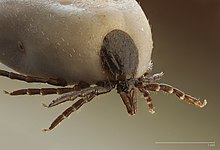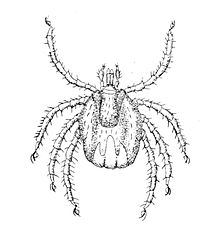
Nuttalliella namaqua is a tick found in southern Africa from Tanzania to Namibia and South Africa, which is placed in its own family, Nuttalliellidae. It can be distinguished from ixodid ticks and argasid ticks by a combination of characteristics including the position of the stigmata, lack of setae, strongly corrugated integument, and form of the fenestrated plates. It is the most basal lineage of ticks.

Amblyomma is a genus of hard ticks. Some are disease vectors, for example the Rocky Mountain spotted fever in Brazil or ehrlichiosis in the United States.

Hyalomma is a genus of hard-bodied ticks common in Asia, Europe, and North Africa. They are also found in Southern Africa. The name is derived from Greek: hyalos (ὕαλος) crystal, glass; and omma (oμμα) eye.
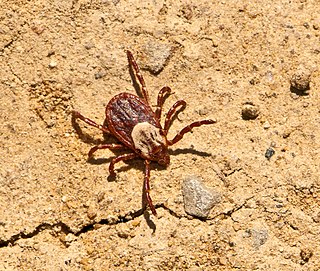
Dermacentor is a genus of ticks in the family Ixodidae, the hard ticks. The genus has a cosmopolitan distribution, with native species on all continents except Australia. Most are found in North America.
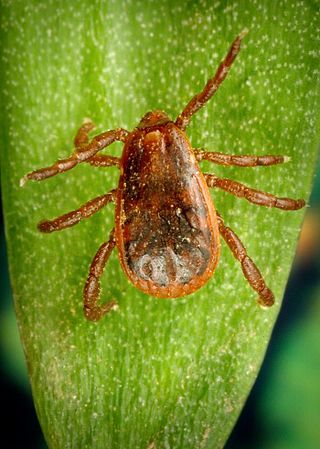
Rhipicephalus is a genus of ticks in the family Ixodidae, the hard ticks, consisting of about 74 or 75 species. Most are native to tropical Africa.

Ornithodoros is a genus in the soft-bodied tick family, Argasidae.
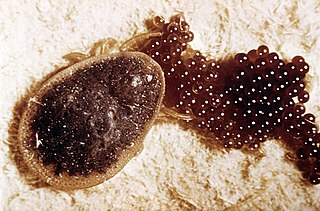
Argas is a genus of tick.

Haemaphysalis is a genus of ticks, containing these species:

Harry Hoogstraal was an American entomologist and parasitologist. He was described as "the greatest authority on ticks and tickborne diseases who ever lived." The American Society of Tropical Medicine and Hygiene's Harry Hoogstraal Medal for Outstanding Achievement in Medical Entomology honors his contributions to science.
Ixodes arboricola, also called the tree-hole tick, is a species of tick that parasitises small passerine birds. It is among the most common species on the house sparrow.
Ixodes hoogstraali is a species of tick endemic to the higher mountains of southwestern Arabia. The type specimens were collected at 7,400 feet (2,300 m) elevation near Ma'bar, Yemen, on king jirds, trapped beside a well in dry fields on a rocky plateau. The species was named in honor of Harry Hoogstraal, who provided the type specimens; the species is closely related to Ixodes ugandanus Neumann, 1906.
Rhipicephalus hoogstraali is a tick found in Djibouti and Somalia. First recognized by Harry Hoogstraal as Rhipicephalus longicoxatus based on an incomplete published description, after discovery of the holotype of R. longicoxatus, it was described and named to honor Hoogstraal in 2009.
Makram Nasri Kaiser (1930–1996) was a medical and veterinary acarologist who was the world's leading authority on ticks of the genus Hyalomma.

Ixodes neuquenensis is a species of tick that lives on the monito del monte, a nocturnal marsupial that lives in the temperate forests of southern South America. Due to the near-threatened status of its host, Ixodes neuquenensis is also at risk.
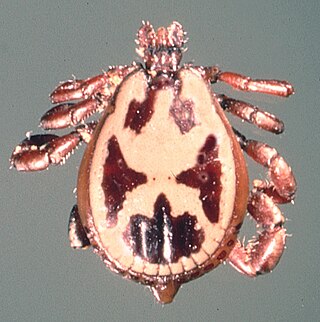
The zebra tick or yellow back tick is a species of hard tick. It is common in the Horn of Africa, with a habitat of the Rift Valley and eastward. It feeds upon a wide variety of species, including livestock, wild mammals, and humans, and can be a vector for various pathogens. The adult male has a distinctive black and ivory ornamentation on its scutum.
Maria Vladimirovna Pospelova-Shtrom (1902–1991) was a 20th century parasitologist best known for her work delineating the biology and public health importance of ticks in western Asia and eastern Europe, contributing to the reduction of the incidence of tick-borne diseases, especially tick-borne relapsing fever.
Ixodes siamensis is an ixodid tick that is parasitic on mammals in Thailand.
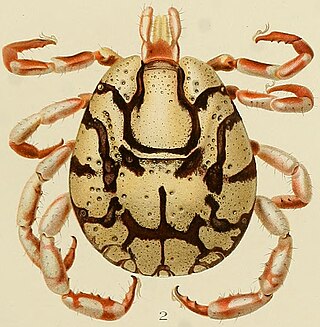
Cosmiomma is a genus of ticks first discovered by Paul Schulze in 1919. It is monospecific, being represented by the single species Cosmiomma hippopotamensis. It was first described in 1843 by Henry Denny from specimens collected from a hippopotamus in Southern Africa, and has been called "one of the most unusual, beautiful, and rare tick species known to the world."

Natalia Aleksandrovna Filippova was a world authority on the taxonomy of mites and especially ticks. Her monographs on the identification, morphology, development, distribution and behaviour of the family Argasidae and the sub-families of Ixodinae and Amblyomminae are standard works on these important vectors of disease.
